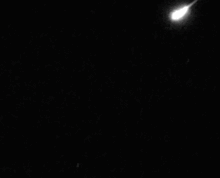- Draconids
-
The October Draconids, in the past also unofficially known as the Giacobinids, are a meteor shower whose parent body is the periodic comet 21P/Giacobini-Zinner. A Draconid meteor shower is expected to happen in early October of 2011, and the best nights for viewing are expected to be October 8–10. The Draconids are best viewed after sunset in an area with a clear dark sky. The 1933[1] and 1946 Draconids had Zenithal Hourly Rates of thousands of meteors visible per hour. Rare outbursts in activity can occur when the Earth travels through a denser stream of the cometary debris; for example, in 1988, rates suddenly spiked[2][3] and spiked again in 2005.[4] Almost all meteors which fall towards Earth burn up and disintegrate long before reaching its surface.
On October 8, 2011, between 16h and 22h Universal Time, the shower is expected to be stronger than normal, and could reach from 60 to 600 meteors per hour for a brief period of time, though a waxing gibbous Moon will disturb the observations in the sense that only the brightest meteors may be visible because of the moonlight.[5][6][7] Predictions vary about how many meteors may be visible during the peak times; some forecasts suggest there could be meteors visible every minute, while other forecasts suggest there could be only a few per hour.[5] Observers in the United Kingdom and Northern Europe are best situated to see the peak activity of the meteor storm on the night of October 8, 2011, (North America will be experiencing daytime when the peak is expected to happen) but meteors may be visible in many locations nevertheless from the 7th through the 9th. For viewing meteors, it is advised to get away from bright lights as much as possible during the night.[5]
References
- ^ John McFarland and Mark Bailey (October 7, 2011). "Account of the 1933 Draconids meteor storm". International Meteor Organization (IMO). http://www.imo.net/docs/ellison_1933_draconids_storm_account.txt. Retrieved 2011-10-08.
- ^ "Giacobinids dazzle observers". October 14, 1998. http://science.nasa.gov/newhome/headlines/ast14oct98_2.htm.
- ^ Arlt, R. "Summary of 1998 Draconid Outburst Observations", WGN, Journal of the International Meteor Organization, Vol. 26, p. 256-259, 1998.
- ^ Campbell-Brown, M.; Vaubaillon, J.; Brown, P.; Weryk, R. J.; Arlt, R. "The 2005 Draconid outburst", Astronomy and Astrophysics, Volume 451, pp.339-344, 2006.
- ^ a b c Adrian West (October 3, 2011). "The Draconid Meteor Shower – A Storm is Coming!". Universe Today. http://www.universetoday.com/89430/the-draconid-meteor-shower-a-storm-is-coming/. Retrieved 2011-10-03. "Observers in the UK and Northern Europe are ideally placed to see the peak of the Draconids. Unfortunately the peak occurs in the day time for North America. There will also be a bright Moon which may drown out many but the brightest meteors, but if predictions are correct, you will still see many. You may see Draconid meteors on the 7th an the 9th also, so it is worth going out and checking the skies."
- ^ "Draconids Meteor Shower on 8 October 2011". International Meteor Organization. http://www.imo.net/draconids2011.
- ^ Beatty, Kelly. "A Deluge of Draconids?". Sky and Telescope. Highlights. http://www.skyandtelescope.com/observing/highlights/104450349.html. Retrieved 31 December 2010.
- Michael D. Reynolds. Falling Stars. Stackpole Books, 2001. p.42.
- Jin-Ichi Watanabe and Mikiya Sato. "Activities of Parent Comets and Related Meteor Showers". Earth, Moon and Planets, Vol 102, No 1-4 (June 2008). p111-116.
- Gary W. Kronk. Draconids
- Draconids 2011 ephemerides
External links
- Draconid Meteors Over Spain (Astronomy Picture of the Day 2011 October 19)

This Meteoroid-, meteor-, or meteorite-related article is a stub. You can help Wikipedia by expanding it.

